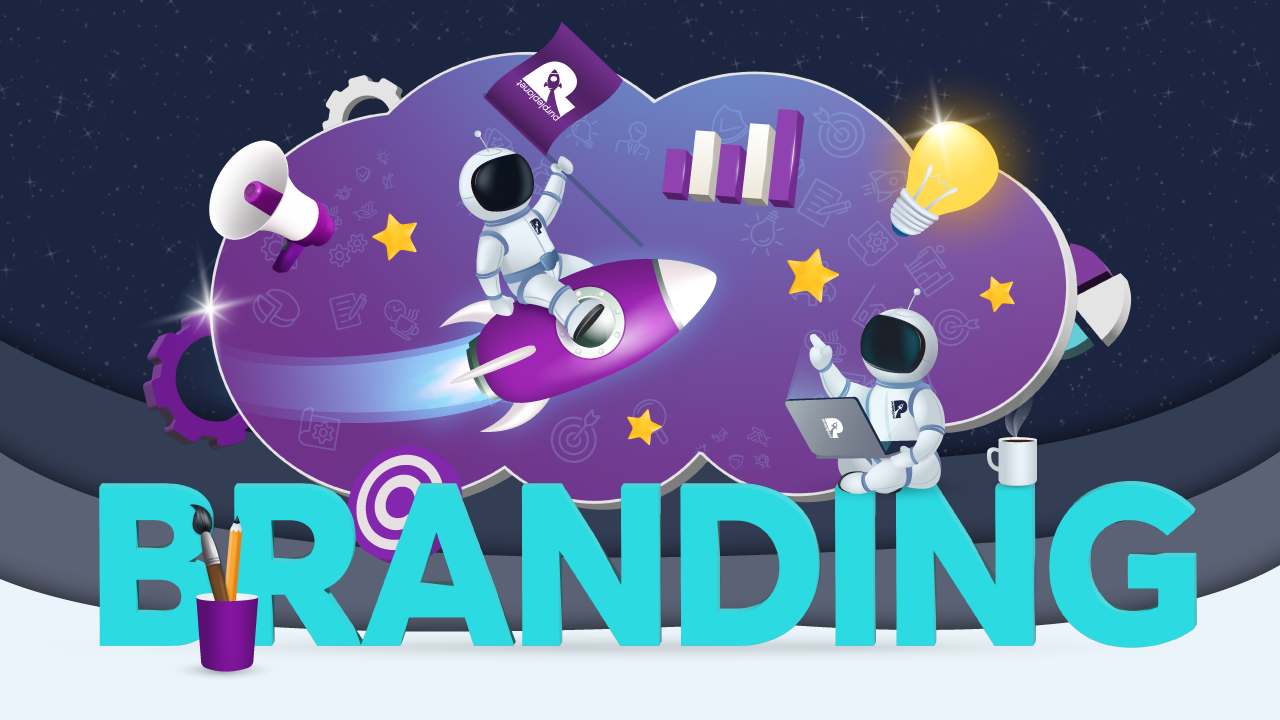

How to Master Storytelling in Website Branding to Connect with Audiences
What is website branding, and why does it matter?
Businesses today need a strong online presence if they want to attract and retain customers.
One of the key components to building a successful online presence, if not the most important, is website branding. Businesses need to create unique identities for themselves through design, content, and messaging if they’re to stand out from a crowded marketplace in today’s digital age.
Website branding matters because it’s often the first point of contact between a business and its customers. Branding can significantly influence how customers perceive and interact with your brand, ultimately impacting their decision to purchase or engage with your business.
What is storytelling, and how does it relate to branding?
Storytelling is a popular and effective way of enhancing branding. While branding always involves communicating brand values, vision, and/or mission, storytelling provides narrative techniques to elevate the effectiveness of those messages.
If executed well, audiences will connect emotionally with the narrative and understand and sympathise with the brand’s unique personality, culture, and purpose. From there, audiences appear more engaged and loyal, while brands appear more trustworthy and stand out from the competition.
Brand stories typically explain how, when, where, and why businesses were started. Plus, they express the hoped-for future of the business, which is usually an idea that consumers can get behind.
In this blog post, we’ll discuss how you can incorporate storytelling into your website branding efforts and overcome some challenges you might face along the way.
How can storytelling enhance website branding?
There are many ways storytelling can enhance your branding. Here are five benefits you can achieve and how to obtain them:
1. Building emotional connections with customers
By giving your audience a reason to care about your brand (beyond just its products or services), you can forge an emotional connection.
You can do this by sharing an emotive story that will resonate with consumers, such as a homegrown business rooted in hardship. Nowadays, people are very concerned about the environment and inequality, so any support for causes like these can help create an emotional response too.
When people feel emotionally invested in a brand, they’re more likely to become repeat customers and brand advocates. Their sense of empathy and loyalty is what drives engagement and sales, which is exactly what branding sets out to achieve.
It might be that your skincare brand was created by people who suffered greatly from acne or that your Wellington boots company gives back to the protection of green spaces. Tapping into the causes that your target audience cares about will be crucial in crafting a believable and enticing brand story.
2. Enhancing brand recognition and differentiation
Brand stories can help raise awareness by capturing the attention of audiences and generating intrigue in a brand. When a brand’s story resonates with customers, they’re much more likely to remember it and seek it out in the future.
The key to achieving this is having a story of genuine interest to your target market and communicating it via eye-catching design.
Furthermore, a well-crafted brand narrative can help differentiate a business from its competitors by highlighting its unique qualities and values. Today’s crowded marketplace means differentiation is absolutely essential for businesses to survive.
Brands can stand out from competitors by sharing a compelling and truly unique brand story. Only then will customers remember them and engage or return.
3. Increasing brand trust and credibility
Having access to a brand’s story can mean a lot to new leads. When they’re researching your products or services, they want to understand more about your business.
So, it’s a good idea to give them something to learn about your business from. Even having a brand story can demonstrate transparency, which is essential if you’re to come across as credible and authentic.
But by being open about your brand’s history, values, and vision, you can show potential customers that yours is a trustworthy company with a personality and backstory of its own.
Did it take a few years for your business to take off? Mention it! Was there a bit of trial and error with product development in the initial stages? Don’t shy away from saying so! Is the owner from humble beginnings? Be honest!
The key to achieving a trustworthy brand image is to be believable. And believable stories aren’t without their failings or negative moments. So, don’t shy away from being honest because a 100% positive story with rainbows and unicorns isn’t real.
4. Creating a consistent brand message
Consistent messaging is key to generating engaged leads that recognise your brand.
Creating a brand narrative can help achieve this because it can influence every part of your business, from marketing, ads, content, visuals, social media, email, and website. With a strong story running through each of these channels, your brand can present a united front and strengthen its strategy from every touchpoint.
5. Enhancing customer loyalty
Once an emotional connection has been forged, audiences begin to build a sort of relationship with brands. Their emotional response triggers an investment into your story, almost as if they were becoming part of that story. So, their purchases from your website and interactions with your brand can be viewed as them taking part in your story, influencing it and merging with it.
This is how brand loyalty is created. Storytelling can help businesses communicate their values and personality to audiences, which they can relate to or not. Those leads that do resonate with a brand story are the ones that will stick around. By tapping into the culture and values of certain groups, businesses can develop stories that resonate with audiences and form the foundations of commitment and trust between brand and customer.
Storytelling can be used to further brand loyalty, too, not just in the initial phases of the buyer’s journey. Email marketing can be a brilliant tool to update customers on the brand’s evolution, deepening their relationship with it.
These factors can lead to increased customer retention and word-of-mouth marketing, as loyal customers are more likely to recommend a brand to their friends and family.
Best practices for brand storytelling
Before your business can achieve the benefits of brand storytelling, you’ll need to know how to execute one successfully. Here are some tips for developing an effective story:
1. Define your brand story clearly
The first step is, of course, defining your brand’s story – but it must be extremely clear. It’s easy to waffle at this stage, but it’s essential that you don’t.
- How, where, when, and why did your brand begin? The answers to these points will form the skeleton of your story.
- Generate ideas by brainstorming words that relate to your brand. Is it fun or formal? Young or wise? Luxury or accessible?
- Next, consider what makes your brand unique, as this will sit centre-stage in defining your company against the rest in its niche.
- What values and mission do you want to communicate to evoke emotional responses in your audience?
- What words and phrases are linked to these values? E.g., “green” for environmental values.
Use the answers to these questions to create a narrative that reflects your brand’s unique identity and personality. You might want to enlist the help of a writer or marketer to perfect the details.
2. Use visuals to enhance your story
Once you’ve defined your story, it’s time to make it visual and bring it to life. Visuals such as images, videos, and graphics can be powerful ways to express your story, and you’ll likely use all of them across your different channels.
Ensure the visual elements you choose, such as colour, words, style, and font, are united with your brand values. E.g., bright colours for a children’s toy brand.
Once you’ve developed a design theme that aligns with your brand narrative, use it consistently to strengthen your messaging across all channels and at every stage of the sales funnel.
3. Tell your story
Once your brand story is ready to be shared, consider the ways in which you’ll distribute it and engage your audience. You might share your story in the following ways:
- Email marketing
- Social media posts (e.g., LinkedIn, Instagram)
- Website pages
- YouTube videos
Storytelling can be executed in a range of ways across these channels:
- Collaborating with other brands and influencers or partnering with a cause-related organisation can help distribute your brand story to a larger audience.
- If you want to create a community around your brand, you might ask followers for user-generated content (UGC).
- You might launch a marketing campaign for a subscription service, inviting customers to engage with your brand while distributing your story via email.
- Some website elements could be made interactive.
- You might offer special sales that match up with key dates in your brand story (e.g., the date the brand was formed or the owner’s birthday).
- For more immersive story distribution, you might like to try podcasts, webinars, and virtual events.
- Those confident in tech might consider utilising new technology, such as augmented reality (AR) or virtual reality (VR), to create immersive experiences that bring your brand story to life.
If you want to focus your resources when you’re just getting started, we’d recommend picking just one or two of these distribution methods. The one you choose should be a channel your audience will most likely engage with, so make sure you do your market research.
Incorporating storytelling into website branding takes time and effort, but the benefits can be significant. Creating a transparent brand narrative that resonates with your customers can enhance your brand loyalty and credibility, differentiate your brand from competitors, and create a memorable identity that stands out in the crowded online marketplace.
Potential challenges of using storytelling in website branding
While storytelling can be a powerful branding tool, there are some potential challenges to be aware of. Make sure you mitigate against the following issues:
Finding the right story
Finding a story that resonates with your customers can be challenging. It requires a deep understanding of your target audience and the values and emotions that will resonate with them. This can be overcome with thorough market and consumer research.
Balancing creativity with authenticity
It’s important to be creative and engaging with your storytelling, but you must also maintain authenticity. If your brand story feels inauthentic or forced, customers will be able to sense it, and it may harm your brand reputation. At the very least, you won’t have a satisfying engagement rate.
To maintain authenticity, it’s essential to stay true to your brand values and mission and avoid exaggerating or embellishing your story or misrepresenting facts and figures.
Consistency across platforms
To be effective, your brand story needs to be consistent across all your website branding efforts and other marketing channels. Ensuring cohesion can be a challenge, especially for larger organisations with multiple teams involved in branding and marketing. However, it is possible to integrate the story throughout the company over time.
Measuring the impact
Measuring the impact of brand storytelling can be difficult. It’s not always easy to quantify the emotional connections and brand loyalty that it can create, and traditional metrics like website traffic and sales may be swayed by other efforts.
Nevertheless, you can still gauge the effectiveness of your strategy with the help of metrics such as engagement rate, social media sentiment analysis, and customer feedback.
Avoiding cultural appropriation
Businesses will need to be sensitive to cultural appropriation when creating a brand story. Using stories or elements from a culture that is not your own without proper understanding, respect, or permission can be insensitive and offensive to customers from that culture.
It’s important to do thorough research and seek expert guidance to avoid appropriating elements from other cultures.
Awareness of these potential challenges can help you to be more successful in your storytelling efforts. By taking the time to develop a clear brand narrative, staying true to your brand values and identity, and being consistent across all platforms, your business can overcome these challenges and reap the benefits of storytelling!
If you’d like help developing your brand’s story, the team here at purpleplanet would love to help! Follow the link below to learn more about our services.











